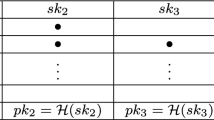Abstract
Merkle tree is considered as a common approach for hash-based post-quantum digital signatures schemes. The tree is used to organise public keys of so called one-time digital signature scheme. The backbone idea of Merkle tree is to iteratively imply hash function. The approach is used in well-known digital signatures schemes such as XMSS and LMS that are standardiseded in IETF. But whether the use of Merkle tree is the only way to organize public keys to build post-quantum digital signature scheme? In the article alternative approaches to organize public keys are considered. The approaches are used to build digital signature schemes. Some features of “new” schemes are pointed out. It is shown that offered approaches have disadvantages that make the “new” schemes impractical.



Similar content being viewed by others
References
Akshay, M.F., Hatkar, S.S.: A novel approach for signing multiple messages: hash-based signature. Int. J. Inf. Comput. Technol. 4, 15 (2014)
Bernstein, D.J., Hopwood, D., Hülsing, A., Lange, T., Niederhagen, R., Papachristodoulou, L., Schneider, M., Schwabe, P., Wilcox-O’Hearn, Z.: Sphincs. In: Oswald, E., Fischlin, M. (eds.) Practical Stateless Hash-Based Signatures. In: Oswald, E., Fischlin, M. (eds) Advances in Cryptology—EUROCRYPT 2015—34th Annual International Conference on the Theory and Applications of Cryptographic Techniques, volume 9056 of Lecture Notes in Computer Science pp. 368–397. Springer (2015)
Brassard, G., Høyer, P., Tapp, A.: In: Quantum counting, vol. 98, pp. 820–831. Springer, London (1998)
Buchmann, J., Dahmen, E., Huelsing, A.: XMSS—A Practical Forward Secure Signature Scheme Based on Minimal Security Assumptions. Lecture Notes in Computer Science volume 7071. Post-Quantum Cryptography (2011)
Buchmann, J., García, L.-C.C., Dahmen, E., Döring, M., Klintsevich, E.: In: Barua, R., Lange, T. (eds) CMSS—An Improved Merkle Signature Scheme. Progress in Cryptology, INDOCRYPT (2006)
Dods, C., Smart, N., Stam, M.: In: Smart, N.P. (ed) Hash based digital signature schemes, cryptography and coding. In: 10th IMA International Conference, Volume 3796 of Lecture Notes in Computer Science, pp. 96–115. Springer (2005)
El Gamal, T.: A public key cryptosystem and a signature scheme based on discrete logarithms. IEEE Trans. Inf. Theory 31(4), 469–472 (1985)
Fluhrer, S.: Further analysis of a proposed hash-based signature standard. eprint.iacr.org/2017/533.pdf, 2017
Grover, L.K.: A fast quantum mechanical algorithm for database search. In: Proceedings, 28th Annual ACM Symposium on the Theory of Computing (1996)
Huelsing, A., Butin, D., Gazdag, S.-L., Rijneveld, J., Mohaisen, A.: XMSS: eXtended Merkle Signature Scheme. RFC 8391 (2018)
Huelsing, A., Rijneveld, J., Song, F.: Mitigating multi-target attacks in hash-based signatures. LNCS vol. 9614 (2016)
Hülsing, A.: W-OTS+—Shorter Signatures for Hash-Based Signature Schemes. In: Youssef, A., Nitaj, A., Hassanien, A.E. (eds) Progress in Cryptology—AFRICACRYPT 2013, 6th International Conference on Cryptology in Africa, Volume 7918 of Lecture Notes in Computer Science, pp. 173–188. Springer (2013)
Information technology. Cryptographic data security. Signature and verification processes of [electronic] digital signature, gost r 34.10-2012. Federal Agency on Technical Regulating and Metrology (2012)
Johnson, D., Menezes, A., Vanstone, S.A.: The elliptic curve digital signature algorithm (ECDSA). Int. J. Inf. Sec. 1(1), 36–63 (2001)
Kaliski, B.: PKCS #1: RSA Encryption Version 1.5. RFC 2313 (1998)
Katz, J.: Analysis of a proposed hash-based signature standard. Contribution to IRTF. http://www.cs.umd.edu/ jkatz/papers/HashBasedSigs.pdf (2015)
Lamport, L.: Constructing digital signatures from a one way function. Technical report, SRI International Computer Science Laboratory (1979)
Leighton, F., Micali, S.: Large provably fast and secure digital signature schemes based on secure hash functions. US Patent 5,432,852 (1995)
McGrew, D., Curcio, M., Fluhrer, S.: Leighton-Micali Hash-Based Signatures. RFC 8554 (2019)
Merkle, R.: A certified digital signature. In: Brassard, G. (eds) Advances in Cryptology-CRYPTO ’89, 9th Annual International Cryptology Conference, Santa Barbara, California, USA, August 20–24, 1989, Proceedings, Volume 435 of Lecture Notes in Computer Science, pp. 218–238. Springer (1989)
Merkle, R.: Secrecy, authentication, and public-key systems. Stanford University, New York (1979).. (PhD Thesis)
National Institute of Standards and Technology (NIST). FIPS Publication 186. Digital Signature Standard (DSS) (1994)
Rescorla, E.: Diffie-Hellman Key Agreement Method. RFC 2631 (1999)
Schnorr, C.: Efficient identification and signatures for smart cards. In: Brassard, G. (ed.) Advances in Cryptology-CRYPTO ’89, 9th Annual International Cryptology Conference, Proceedings, Volume 435 of Lecture Notes in Computer Science, pp. 239–252. Springer, Santa Barbara (1989)
Scott, A., Yaoyun, S.: Quantum lower bounds for the collision and the element distinctness problems. J. ACM 51(4), 595–605 (2004)
Author information
Authors and Affiliations
Corresponding author
Additional information
Publisher's Note
Springer Nature remains neutral with regard to jurisdictional claims in published maps and institutional affiliations.
Rights and permissions
About this article
Cite this article
Guselev, A., Lavrikov, I. Is Merkle tree the best option to organize keys?. J Comput Virol Hack Tech 18, 25–29 (2022). https://doi.org/10.1007/s11416-021-00400-3
Received:
Accepted:
Published:
Issue Date:
DOI: https://doi.org/10.1007/s11416-021-00400-3




